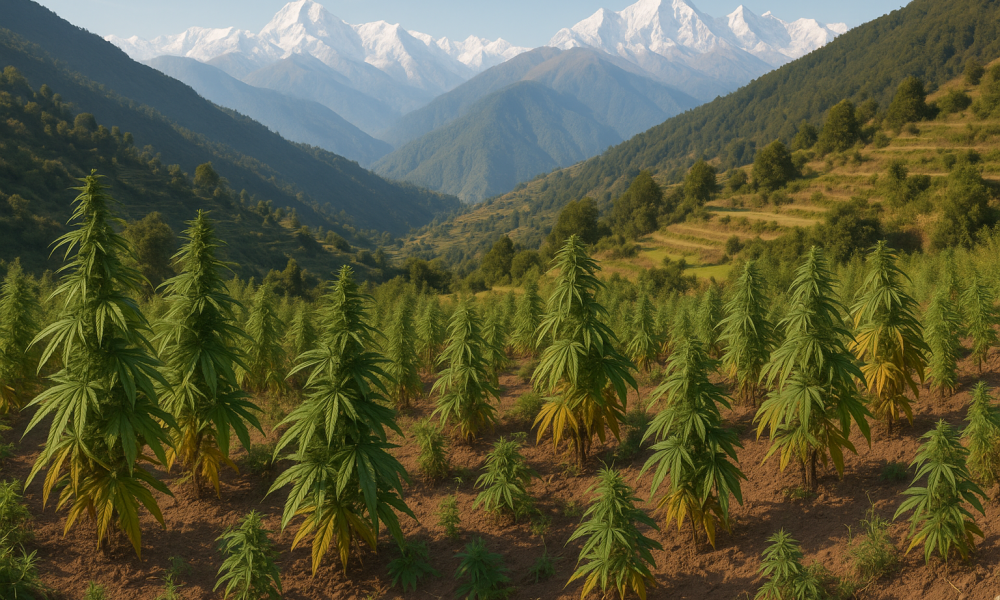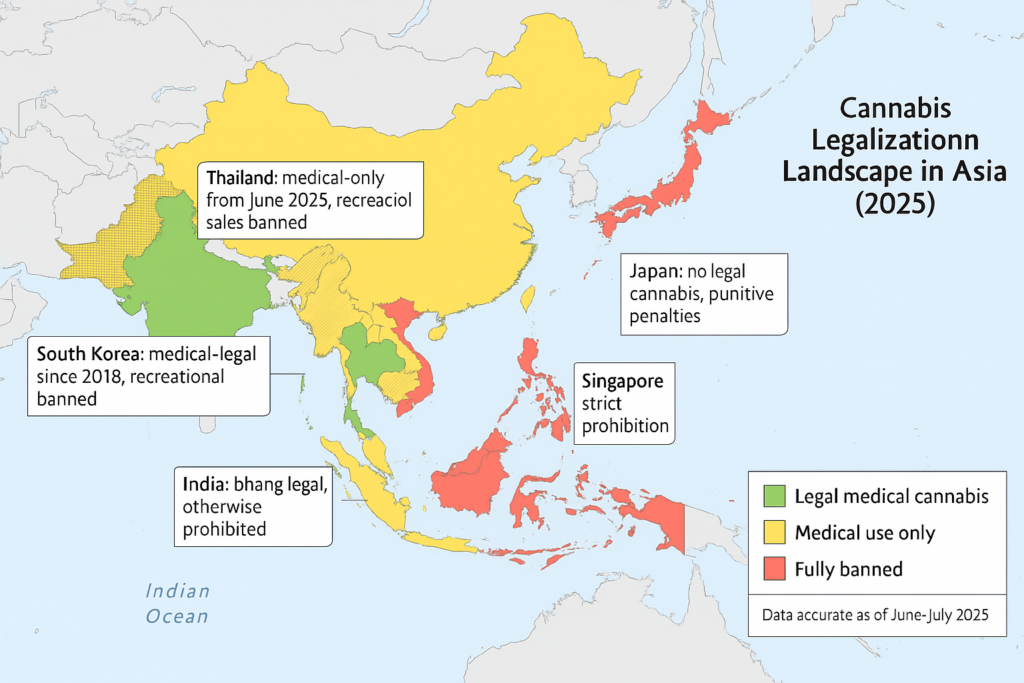Smoking Traditions: What You Never Knew About Weed in Asia

🌿A Green Mystery Wrapped in Smoke
When most people think about cannabis, their minds go straight to Amsterdam’s coffee shops, California dispensaries, or Canada’s progressive laws. Rarely do they imagine the ancient temples of India, the serene monasteries of Tibet, or the lush highlands of Thailand. But here’s the twist: Asia isn’t just part of the cannabis story—it’s where the story begins.
Yes, that’s right. Cannabis most likely originated in Central Asia thousands of years ago, and from there it spread along trade routes, over mountains, and into medicine cabinets and sacred ceremonies across the continent. Before it became a “controversial substance” in modern politics, it was a spiritual tool, a healing herb, and a cultural staple.
Yet today, Asia finds itself in a paradox. While some countries are cautiously exploring legalization, others still enforce harsh punishments. Culturally, cannabis is woven into traditional ceremonies in places like India and Nepal, yet it’s also feared or misunderstood in countries like Japan and Malaysia.
This duality—the clash between ancient acceptance and modern criminalization—is what makes Asia’s cannabis culture so fascinating and often misunderstood. And that’s exactly what this article will uncover: a journey from the past to the present, from tradition to transformation, all rolled into a single deep dive into weed in Asia.
🧭Cannabis Through the Ages in Asia
Let’s rewind time for a moment.
Long before modern governments began drafting legislation about cannabis, ancient civilizations across Asia were already growing, harvesting, and using the plant for a wide range of purposes. In fact, cannabis is believed to have been one of the first plants ever cultivated by humans, with archaeological evidence tracing its roots back over 10,000 years in Central Asia.
📍 China: The Medical Pioneer
In China, cannabis was recognized as a therapeutic herb as far back as 2700 BCE. It appeared in the legendary “Shennong Ben Cao Jing” (The Classic of Herbal Medicine), attributed to Emperor Shen Nung. The plant was used to treat ailments such as constipation, pain, malaria, and even mental illness. Hemp fibers were also used in textiles, rope, and early forms of paper.
📍 India: Sacred & Sensory
India’s relationship with cannabis is equally ancient—but far more spiritual. In Vedic texts written between 1500–500 BCE, cannabis (referred to as bhang) is considered one of the five sacred plants, said to relieve anxiety and connect people to the divine. Hindu mythology even tells of Lord Shiva retreating to the mountains and drinking bhang to relax and meditate.
Bhang is still legally consumed during religious festivals, especially Holi and Maha Shivaratri, where people mix cannabis leaves with milk, nuts, and spices to create a drink believed to enhance spiritual consciousness and joy.
📍 Tibet & Nepal: Mountains and Mindfulness
In the Himalayan regions of Tibet and Nepal, cannabis found a place in shamanic practices and monastic rituals. Some Tibetan Buddhist monks reportedly used cannabis in small doses to aid in prolonged meditation and inner visualization. Meanwhile, in Nepal, hashish was once legally sold in government-licensed shops in Kathmandu before U.S.-influenced policies banned it in the 1970s.
📍 Southeast Asia: Functional & Folk
In Vietnam, Thailand, Laos, and Cambodia, cannabis was grown for both industrial and medicinal use. Farmers used it to make fishing nets and ropes, while traditional healers applied it in balms and teas for muscle pain, fever, and digestive issues.
So, while the Western world only “discovered” cannabis a few centuries ago, Asia has been living with it for millennia—as medicine, fiber, food, and spiritual guide.
🍃Spiritual Smoke: Cannabis in Religion and Ritual
🕉️ India: Worshipping Shiva with Smoke

Among the most vivid examples is the Hindu worship of Lord Shiva, the god of destruction and rebirth. Devotees believe Shiva consumed cannabis to calm his cosmic rage and retreat into meditation. As a result, cannabis became not just acceptable—but sacred.
During Maha Shivaratri, temples across India (especially in places like Varanasi and Haridwar) come alive with music, fire, and color. Sadhus—Hindu holy men covered in ash and dreadlocks—can be seen smoking charas (hand-rolled hashish) in long chillum pipes, often as part of deeply meditative or religious practices. But to them, this is not “getting high.” It’s about transcendence.
🔮 Nepal: The Himalayan Ritual
In Nepal, cannabis is native to the hills and plays a role in both religious and folk traditions. During Shivaratri, the holy site of Pashupatinath Temple becomes a gathering spot for pilgrims and sadhus alike, who offer cannabis to Shiva and consume it in ritualistic ways.
While technically illegal in Nepal, the government tends to turn a blind eye during religious festivals, acknowledging the plant’s place in spiritual culture.
🧘 Tibet & Inner Asia: Meditation and Mind Expansion

In Tibetan Buddhism, there’s historical evidence that small amounts of cannabis were used by monks during extended meditation retreats. It’s believed the herb was used to deepen sensory experience, enhance visualization, and quiet the mind. Though not widely discussed in public Buddhist doctrine today, references exist in 18th-century Tibetan texts about using cannabis in Tantric rituals.
🏕️ Tribal Southeast Asia: Animism & Healing
Among tribal and indigenous groups in places like Laos and northern Thailand, cannabis was often part of shamanic healing. It was smoked or infused in teas during ceremonies to ward off evil spirits or connect with ancestors. These traditions still survive in some rural areas, passed down orally and practiced discreetly.
In these traditions, cannabis is more than a “drug”—it’s a tool of insight, healing, and connection to the unseen.
🚫How Colonialism Changed Everything
Despite its deep roots, cannabis became stigmatized in many parts of Asia during the colonial era. The British Empire criminalized its use in India by the 19th century (though they still taxed bhang). In Japan, post-World War II American influence led to the Cannabis Control Law of 1948, criminalizing possession and cultivation.
Fast forward to the War on Drugs in the 1970s and 1980s, and much of Asia followed suit with zero-tolerance policies. Places like Singapore, Indonesia, Malaysia, and the Philippines instituted harsh penalties—even the death sentence—for drug-related offenses.
Ironically, many of these nations once valued cannabis as medicine or a sacred herb, but were swept into a wave of prohibition not entirely rooted in their own traditions.
🌏 Weed in Modern Asia: Where It’s Legal, Banned, or In Transition (2025)
While Asia has been historically strict, change is in the air. A few brave countries are rethinking cannabis—not just for medicine, but for cultural, economic, and even wellness reasons.
Here’s a country-by-country breakdown of what’s happening now:

🌿 Thailand:
In 2022, Thailand became the first Asian country to legalize cannabis cultivation and consumption (with restrictions). This landmark decision made global headlines and sparked a wave of startups, cannabis cafes, and tourism.
💊 South Korea & Japan:
Both allow limited medical cannabis use, mostly in tightly regulated pharmaceutical formats. Cultural stigma remains, but interest is growing.
🛑 Singapore, Malaysia, Indonesia, Philippines:
These countries remain strict, with capital punishment still on the books for trafficking. Even minor possession can lead to years in prison.
🧘 India & Nepal:
Cannabis is technically illegal, but bhang is legal and widely consumed during Hindu festivals. The black market thrives, and many hope India will soon explore broader reform.
🧬 What Research Reveals About Asian Cannabis Genetics
Let’s get into the genetics—and no, you don’t need a PhD to understand this part.
In recent years, geneticists and botanists have mapped the cannabis genome, and guess what they discovered? Cannabis likely originated in Central Asia, specifically around the region that includes modern-day Mongolia, Kazakhstan, and northwestern China.
🔍 What Does This Mean?
It means the cannabis strains native to Asia—often called “landrace strains”—have been shaped for thousands of years by climate, altitude, soil, and human selection. Unlike modern hybrid strains that are crossbred for certain effects or yields, landraces are pure, unaltered by globalization or commercial farming.
🌱 Examples of Asian Landrace Strains:
- Thai Stick – A tall, potent sativa from Thailand known for its euphoric high and spicy aroma.
- Malana Cream – A legendary hash-producing indica from the Himalayan village of Malana in India.
- Yunnan – A unique strain from China with both indica and sativa traits, prized for its earthy, calming effects.
- Luang Prabang – A lesser-known but highly resilient landrace from Laos.
- Afghani Kush – Technically South-Central Asia, this strain has been the backbone of many modern hybrids due to its high resin content.
A groundbreaking 2021 paper published in Science Advances used genome sequencing on over 100 cannabis samples and concluded that:
- Cannabis was first domesticated in Asia around 12,000 years ago
- There are four genetically distinct cannabis populations, and three are based in Asia
- The region still harbors wild cannabis populations that could be critical for future medical and commercial breeding
Preserving and studying Asian landrace strains isn’t just about nostalgia—it’s about biological diversity. These strains could hold the key to breeding new plants that are:
- Naturally pest-resistant
- More tolerant to climate change
- Rich in rare cannabinoids like THCV or CBG
So yes, science is catching up to what ancient cultures already knew: Asia’s cannabis plants are unique, powerful, and full of potential.
💰 Asia’s Budding Cannabis Industry
Asia is poised to become one of the largest cannabis markets in the world—if it plays its cards right.
According to a 2024 report by Prohibition Partners, the Asian cannabis market could be worth $120 billion by 2030 if more countries legalize medical or recreational use.
Thailand’s early move has attracted foreign investment, local entrepreneurs, and tourism dollars. Meanwhile, Chinese biotech firms are exploring CBD extraction and hemp cultivation for wellness and textiles.
In 2023, Thai-based company “Golden Triangle Group” launched an international CBD line. Their products now ship to the U.S., U.K., and Australia, showing how Asia can pivot from prohibition to profit.
🤝 Cultural Stigma vs. Youth Rebellion: The Generational Divide
Despite progress, cannabis use in Asia still carries heavy stigma, especially among older generations who associate it with crime or laziness.
But younger Asians—raised on global media and wellness culture—are pushing back.
In Seoul, underground cannabis cafes are popping up disguised as tea shops. On TikTok, Japanese influencers talk about microdosing for stress and anxiety—even if it’s technically illegal.
This generational divide may shape the future of legalization more than policy alone.
📘 Pro Terms You Should Know in the Asian Cannabis Scene
| Term | Meaning |
| Landrace | A cannabis strain native to a region and unaltered by crossbreeding. |
| Bhang | A traditional Indian cannabis preparation mixed with milk and spices. |
| Ganja | Common term for marijuana in India and Southeast Asia. |
| Chillum | A conical clay pipe used by sadhus and spiritual practitioners. |
| CBD | Cannabidiol; non-psychoactive cannabinoid used for wellness. |
| THC | Tetrahydrocannabinol; the main psychoactive compound in cannabis. |
| Decarboxylation | Heating cannabis to activate cannabinoids like THC and CBD. |
| Hemp | A variety of cannabis with low THC, used for textiles, food, and CBD. |
| Cannabis Tourism | Traveling to destinations where cannabis use is legal or culturally significant. |
| Shamanic Use | Traditional spiritual or healing use of cannabis by tribal or indigenous communities. |
🛒 Ready to Stock the Best? Let’s Do Business
Are you a wholesale buyer or cannabis business looking to source the highest-quality seeds and products from world-class breeders? Visit our shop page now and explore a curated collection of top-tier genetics from trusted seed banks.
💬 What Do You Think?
Have you experienced cannabis culture in Asia firsthand? Or are you surprised by what you’ve learned here?
Drop a comment below—we’d love to hear your thoughts, questions, or even your own green travel stories.
